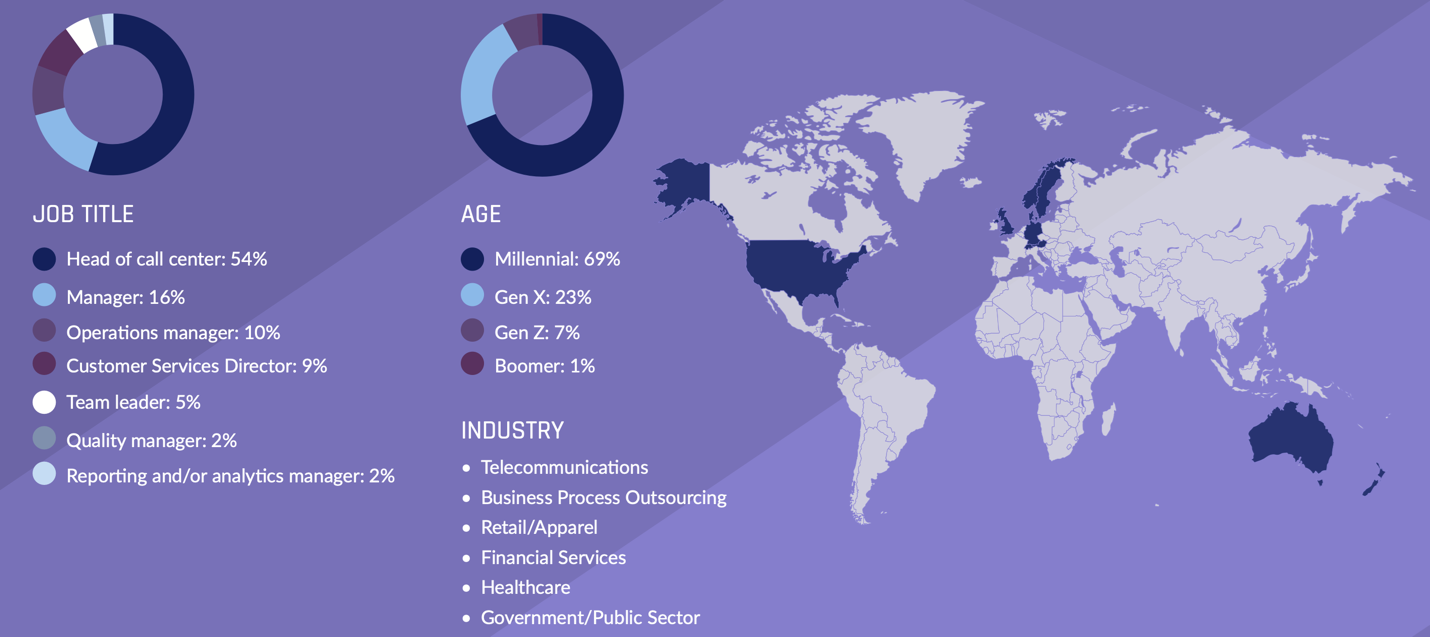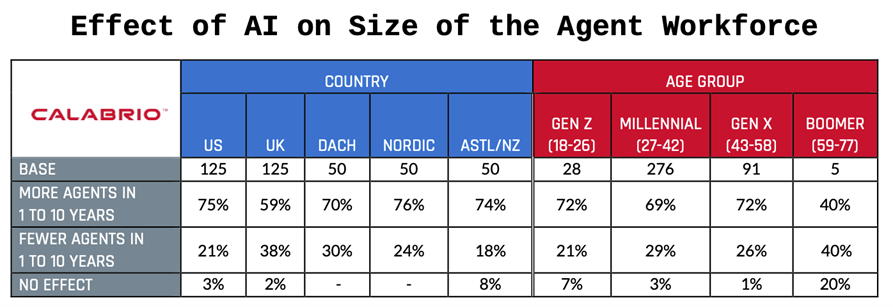Welcome to No Jitter's Number of the Month, where we dig deeper into the research and data that's shaping the communications technology industry. This month, we look at Calabrio’s State of the Contact Center 2023: Activating the Agent of the Future report and one stat from that report: 70% of contact center managers believe AI will mean there will be more agents in the next 10 years—not fewer. In other words, AI is not coming for contact center agents’ jobs.
This point appears counterintuitive. One major benefit of generative and predictive AI alike is improved productivity – doing more with less. AI-powered virtual agents are usually placed in front of the contact center to divert, contain and/or triage calls – i.e., automate routine service/support and then pass along the inquiries that require human agents. For example, this Nielsen Norman Group article cites Erik Brynjolfsson, Danielle Li & Lindsey R. Raymond’s “Generative AI at Work” study that found that support agents using an OpenAI-based AI tool could handle 13.8% more customer inquiries per hour.
With the right data, conversational AI solutions and/or LLMs, shouldn’t these virtual agents be taking the bulk of calls that used to go to humans? And with the right AI-powered tools, shouldn’t agents be able to take on more calls – thus reducing the number of agents needed to sustain call volume in any contact center?
Perhaps the key to making sense of the counterintuitive idea that there might be more agents in 10 years is to consider this possibility: that contact center hiring won’t dip because agents’ roles are likely to evolve in ways that only humans can fulfill.
Focus on the number of the month: 70%
That number comes from the State of the Contact Center 2023 report which was conducted with 400 contact center managers from six industries, four age groups and ten countries: U.S., U.K., Germany, Austria, Switzerland, Denmark, Norway, Sweden, New Zealand and Australia. The following graphic shows the distribution of respondents by job title, age and industry.
Why?
The following table shows how the survey’s sample (Base=400) breaks out by age and country category. The 70% comes from the total percentage of respondents, which is not shown in the following table). But, 24% of all respondents said they believed AI would result in more agents in 1-5 years and 46% of respondents said they believed AI would result in more agents in 5-10 years (added together, that’s 70%).
As shown in the table below, Millennials comprised the largest (69%) demographic, followed by Gen Xers. Note that Calabrio did not control the sample by demographic, so this is just how the data “fell out,” so to speak, based on who Calabrio was looking to survey (job function), which industry and where they were located (country). (Note: DACH includes Germany, Austria, Switzerland; NORDIC includes Denmark, Norway, Sweden; ASTL is Australia and NZ is New Zealand.)
“What struck me was how low the boomer percentage was,” said Sheila McGee-Smith, President & Principal Analyst of McGee-Smith Analytics, L.L.C. As the chart above indicates, only one percent of the respondents were Boomers and, as mentioned, Calabrio did not control the sample size by age.
“For a few years now we've been talking about how it's a four-generation contact center,” McGee-Smith continued, meaning that people from four generations work in the contact center. These survey results suggest that “while it’s decreasingly a four-generation contact center, it is becoming more of a Millennial contact center, and I think that has repercussions for the willingness to adopt technology.”
Previous Number of the Month features have highlighted the greater comfort level Millennials and Zoomers have with personalization and AI relative to Gen Xers and Boomers, so perhaps their cohort’s well-documented willingness to embrace AI in their personal lives would extend into the workplace. Still, the survey results split by age (above) show basically equivalent optimism regarding AI’s impact on agent employment. (Note that the Boomer sample is too small to really trust those results.)
There is also the possibility that the survey respondents – people involved in the day-to-day management of people and systems in contact centers – prefer to believe that AI’s encroachment would not negatively impact how they’re running contact centers or how many agents they employ. They may want to look up the org chart for an alternate perspective.
“I think if this same question had been offered to CEOs, CIOs, or CMOs, you would have gotten very different results,” McGee-Smith said. “One of the things that is definitely happening in the market, especially right now because of macro conditions, is a desire to increase the proportion of interactions that are automated with the goal of having fewer agents over time.”
According to the SQM Group, the average call center agent turnover (or attrition rate) was 35% in 2021 and 38% in 2022. (SQM defines the “attrition rate” as the number of agents who left a call center in a year divided by the average number of agents who worked there in that year.) SQM says that “prior to 2018, call center turnover was under 25% and fairly stable. Based on call center turnover for the last two years, the industry standard for call center turnover is 30 to 40 percent.”
The Generative AI study cited earlier provides different statistics and sources that shed further light on the challenges faced by contact centers:
- The average supervisor spends at least 20 hours per week coaching lower-performing agents (Berg et al., 2018)
- Faced with variable productivity, high turnover, and high training costs, firms are increasingly turning toward AI tools (Chui et al., 2021)
The Generative AI study also found that the use of AI tools “accelerated the learning curve for new agents. On average, new agents complete 2.0 customer inquiries per hour. After 8 months, their productivity increases to 2.5 inquiries per hour (without AI help). In contrast, the agents who started using the AI tool right off the bat reached this level of performance in only two months. Even better, the AI-using agents reached a performance of 3.0 inquiries per hour after 5 months of experience.”
Moreover, the Generative AI study found that AI tools were likely to reduce agent attrition: “[On] average, the likelihood that a worker leaves in the current month goes down by 8.6 percentage points.” That study also found that the strongest reductions in attrition was among agents with less than 6 months of experience. “The magnitude of this coefficient, around 10 percentage points, is large given baseline attrition rates for newer workers of about 25 percent.”
Given what we know about agent attrition rates per the Generative AI study, if AI tools reduce attrition, there’s a real impact on the organization’s bottom line. So perhaps AI tools are becoming available exactly when the industry is potentially facing a situation which AI tools are uniquely suited to assist with.
High turnover obviously means more new agents coming on board. If the referenced Generative AI study is correct, then AI can help those agents become more proficient faster – that is one key benefit cited in the Traeger case study NJ published recently – then customer service/support and overall experience levels can potentially be maintained and/or improved.
“In the short-term, companies are viewing generative AI and AI as a way of automating routine tasks like password resets and package tracking. If viewing AI solely for its ability to automate and handle a significant portion of interactions, then one would envision a future that entails reduced agent head count in the contact center,” said Mila D’Antonio, Principal Analyst, Customer Engagement with Omdia. (Note: Omdia and No Jitter are both part of Informa Tech).
She continued, “AI’s ability to handle more complex inquiries will require human expertise and the need for specialized agents. This will require the hiring or training of agents with unique skillsets who can handle complex inquiries and provide industry-focused or specialized skillsets.”
And this goes to the point raised earlier – analysts see agents’ roles and responsibilities as likely to evolve.
“The deployment of AI will require contact centers to shift to more specialized roles, such as data analysts, AI trainers, and customer experience designers, who work alongside human agents,” D’Antonio said. “So as AI advances, companies may find themselves creating new roles within the contact center to meet the new demands and therefore offset any reductions in agent positions.”
And thus does today’s contact center agent evolve into tomorrow’s. Maybe.











